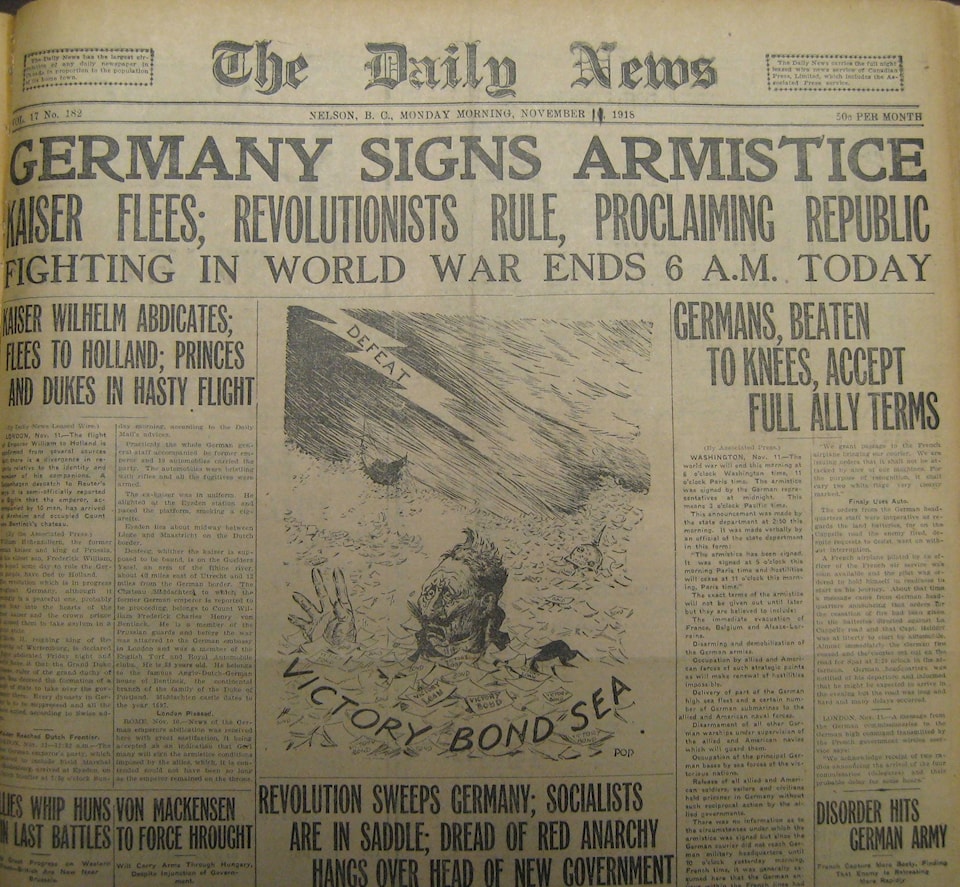From the files of the Nelson Daily News
November 12, 1918
‘Three cheers and a tiger’ reached from one end of Baker Street to the other yesterday. Church bells were rung, whistles were blown, and flags waved from every window. Nelson was celebrating the great news that victory was won. Soon after the tidings had been announced in the headlines of The Daily News, Mayor McQuarrie proclaimed a civic half-holiday and a big parade was arranged for the afternoon. Shortly after 2 o’clock the monster parade began to assemble outside the Great War veterans clubrooms. Headed by the fire truck driven by Chief Guthrie, the procession which included a large number of returned soldiers, members of the city band and bugle band, pipers, boy scouts and about 27 automobiles, ended its way down Stanley Street, along Baker, through the main thoroughfares of the city and came to a halt at the corner of Ward and Baker Streets, where an open air mass meeting was held. In the evening a large crowd gathered in the recreation grounds to witness the burning of a life size effigy of the German Kaiser and of a monster miniature submarine.
November 14, 1918
The honor flag won by Nelson on Saturday night when the city reached its Victory Loan quota of $400,000 was presented at a luncheon at the Hume Hotel yesterday at noon. The Victory Loan has now been oversubscribed a week ahead of the closing date of the campaign. Last night the grand total to date was announced to be $476,000 and indications are that a total of $500,000 will be reached by the next Saturday closing. The flag was not unfurled at the meeting as the districts have decided that they would rather have the ceremony at public meetings, which will be held as soon as the influenza epidemic has subsided. (Ed note: final total for the Nelson District was $552,400 which would be approximately $8,027,813 in 2018)
November 16, 1918
About 900 cases of Spanish influenza have occurred in the city since the beginning of the epidemic four weeks ago. The death rate has been very low compared with that of other districts, taking into consideration the number of patients who have been ill with the disease. There have been 15 deaths altogether. The epidemic situation, though well under control, was not so bright yesterday as it had been for the last few days, and it is thought that the peace celebrations and gatherings which were held at the beginning of the week had caused it to break out again. Most of the later cases have been found to be milder than those which occurred at the beginning of the epidemic.
November 21, 1918
With every available resource in the district thrown into the battle to save the life of Mayor Mungo R. McQuarrie, who lies critically ill with pneumonia. Pulmoters were rushed in to the city from the Silver King mine and from Trail. Oxygen had been administered for some hours and it was when the supply in the city began to run out that pulmotors were secured from the Silver King mine and the Trail smelter. That from Trail was hurried by automobile to Castlegar and from Castlegar it was brought by gasoline speeder. The trip was made by car as far as the snowline to obtain the pulmotor from the Silver King. It was brought down to the snowline by Mr. Wood from the mine, who made the trip on snowshoes. The auto party left Nelson at 9:30 o’clock last night and reached the city on the return journey about 11:30 this morning. Mayor McQuarrie was one of the most active workers in the fight against Spanish influenza when the disease was at its peak in the city and scores of persons were lying in their homes in need of attention, and he was stricken with the disease about a week ago. (Mungo Robert McQuarrie, Mayor of Nelson, passed away at five minutes to 12 that evening)
November 27, 1918
City schools will remain closed for the present. This was the decision finally reached by the members of the school board after a discussion which lasted for nearly an hour and in which Dr. Isobel Arthur, medical health officer, strongly advocated that the schools remain closed. The doctor pointed out that while the epidemic was on the wane and generally considered practically over, it was, never less, necessary to take the greatest precaution at the present time to avoid a fresh outbreak. The trustees were of the opinion that the schools should be opened as soon as possible in fairness to the pupils from a book point of view.
